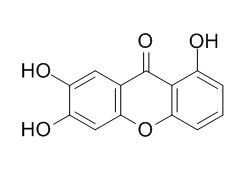1,6,7-Trihydroxyxanthone
1,6,7-Trihydroxyxanthone has anti-cancer activity ,at least in part, through the activation of miR-218 and suppression of Bmi-1 expression; can suppress cell growth and induce apoptosis in liver cancer cells.
Inquire / Order:
manager@chemfaces.com
Technical Inquiries:
service@chemfaces.com
Tel:
+86-27-84237783
Fax:
+86-27-84254680
Address:
1 Building, No. 83, CheCheng Rd., Wuhan Economic and Technological Development Zone, Wuhan, Hubei 430056, PRC
Providing storage is as stated on the product vial and the vial is kept tightly sealed, the product can be stored for up to
24 months(2-8C).
Wherever possible, you should prepare and use solutions on the same day. However, if you need to make up stock solutions in advance, we recommend that you store the solution as aliquots in tightly sealed vials at -20C. Generally, these will be useable for up to two weeks. Before use, and prior to opening the vial we recommend that you allow your product to equilibrate to room temperature for at least 1 hour.
Need more advice on solubility, usage and handling? Please email to: service@chemfaces.com
The packaging of the product may have turned upside down during transportation, resulting in the natural compounds adhering to the neck or cap of the vial. take the vial out of its packaging and gently shake to let the compounds fall to the bottom of the vial. for liquid products, centrifuge at 200-500 RPM to gather the liquid at the bottom of the vial. try to avoid loss or contamination during handling.
Foods.2023, 12(6):1227.
J Ethnopharmacol.2017, 196:75-83
Food Chem.2019, 278:683-691
Int J Mol Sci.2024, 25(22):12152.
J Ethnopharmacol.2024, 320:117426.
Br J Pharmacol.2020, 10.1111
Horticulture Research2023, uhad259
Pharmaceuticals (Basel).2024, 18(1):19.
Nutrients.2021, 13(10):3414.
Appl. Sci.2023, 13(2), 860.
Related and Featured Products
Bellidifolin
Catalog No: CFN89132
CAS No: 2798-25-6
Price: $268/10mg
Gentisein
Catalog No: CFN92398
CAS No: 529-49-7
Price: Inquiry(manager@chemfaces.com)
1,3,5-Trihydroxyxanthone
Catalog No: CFN92399
CAS No: 6732-85-0
Price: Inquiry(manager@chemfaces.com)
1,3,5,6-Tetrahydroxyxanthone
Catalog No: CFN92539
CAS No: 5084-31-1
Price: Inquiry(manager@chemfaces.com)
1,3,6-Trihydroxy-5-methoxyxanthone
Catalog No: CFN92540
CAS No: 41357-84-0
Price: Inquiry(manager@chemfaces.com)
3,8-Dihydroxy-2,4,6-trimethoxyxanthone
Catalog No: CFN92556
CAS No: 65008-17-5
Price: Inquiry(manager@chemfaces.com)
1,6,7-Trihydroxyxanthone
Catalog No: CFN98284
CAS No: 25577-04-2
Price: Inquiry(manager@chemfaces.com)
Norathyriol
Catalog No: CFN98468
CAS No: 3542-72-1
Price: $368/5mg
Montixanthone
Catalog No: CFN91903
CAS No: 876305-36-1
Price: Inquiry(manager@chemfaces.com)
3,6-Dihydroxy-1,7-dimethoxyxanthone
Catalog No: CFN89303
CAS No: 262292-34-2
Price: Inquiry(manager@chemfaces.com)
Apoptosis. 2015 Jan;20(1):75-82.
MiR-218-targeting-Bmi-1 mediates the suppressive effect of 1,6,7-trihydroxyxanthone on liver cancer cells.[Pubmed:
25416134]
METHODS AND RESULTS:
In the present study, an active ingredient, 1,6,7-Trihydroxyxanthone (THA), derived from Goodyera oblongifolia was found to strongly suppress cell growth and induce apoptosis in liver cancer cells. MicroRNAs are a group of small non-coding RNAs that regulate gene expression at post-transcriptional levels. Our results demonstrated that miR-218 was up-regulated and oncogene Bmi-1 was down-regulated by 1,6,7-Trihydroxyxanthone treatment. Further investigation showed that 1,6,7-Trihydroxyxanthone-induced-miR-218 up-regulation could lead to activation of tumor suppressor P16(Ink4a) and P14(ARF), the main down-stream targets of Bmi-1.
CONCLUSIONS:
In conclusion, 1,6,7-Trihydroxyxanthone might be a potential anti-cancer drug candidate, at least in part, through the activation of miR-218 and suppression of Bmi-1 expression.



